Top Rankings
Stanwood-Camano School District ranks among the top 20% of public school district in Washington for:
Category
Attribute
Community Size
Largest student body (number of students) (Top 1%)
For the 2025 school year, there is 1 public preschool serving 467 students in Stanwood-Camano School District. This district's average pre testing ranking is 7/10, which is in the top 50% of public pre schools in Washington.
Public Preschool in Stanwood-Camano School District have an average math proficiency score of 42% (versus the Washington public pre school average of 43%), and reading proficiency score of 52% (versus the 49% statewide average).
Minority enrollment is 21% of the student body (majority Hispanic), which is less than the Washington public preschool average of 54% (majority Hispanic).
Overview
This School District
This State (WA)
# Schools
11 Schools
801 Schools
# Students
4,861 Students
280,418 Students
# Teachers
249 Teachers
17,799 Teachers
Student : Teacher Ratio
20:1
20:1
District Rank
Stanwood-Camano School District, which is ranked within the top 30% of all 306 school districts in Washington (based off of combined math and reading proficiency testing data) for the 2021-2022 school year.
The school district's graduation rate of 90% has increased from 84% over five school years.
Overall District Rank
#82 out of 307 school districts
(Top 30%)
(Top 30%)
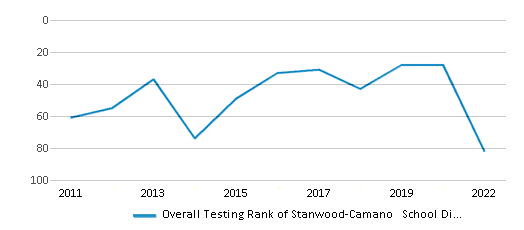
Math Test Scores (% Proficient)
40%
40%
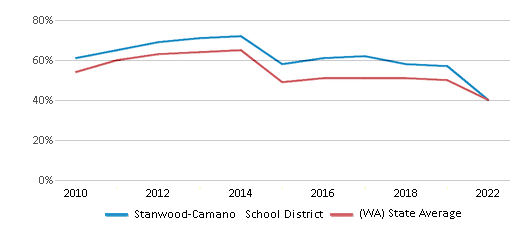
Reading/Language Arts Test Scores (% Proficient)
58%
53%
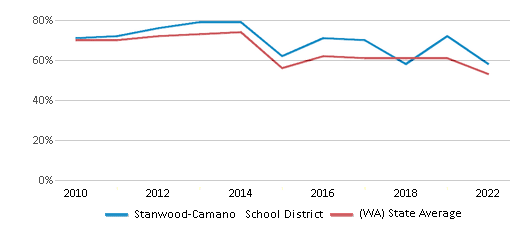
Science Test Scores (% Proficient)
53%
49%
Graduation Rate
90%
84%

Students by Ethnicity:
Diversity Score
0.40
0.71
# American Indian Students
63 Students
2,844 Students
% American Indian Students
1%
1%
# Asian Students
106 Students
25,971 Students
% Asian Students
2%
9%
# Hispanic Students
586 Students
73,094 Students
% Hispanic Students
12%
26%
# Black Students
53 Students
16,473 Students
% Black Students
1%
6%
# White Students
3,719 Students
129,086 Students
% White Students
77%
46%
# Hawaiian Students
25 Students
5,103 Students
% Hawaiian Students
1%
2%
# Two or more races Students
296 Students
27,229 Students
% of Two or more races Students
6%
10%
Students by Grade:
# Students in PK Grade:
59
23,952
# Students in K Grade:
347
43,573
# Students in 1st Grade:
358
42,048
# Students in 2nd Grade:
370
43,955
# Students in 3rd Grade:
376
39,809
# Students in 4th Grade:
368
41,098
# Students in 5th Grade:
386
39,252
# Students in 6th Grade:
365
3,085
# Students in 7th Grade:
375
1,010
# Students in 8th Grade:
346
1,067
# Students in 9th Grade:
389
319
# Students in 10th Grade:
397
337
# Students in 11th Grade:
362
333
# Students in 12th Grade:
363
580
# Ungraded Students:
-
-
District Revenue and Spending
The revenue/student of $19,141 is higher than the state median of $18,796. The school district revenue/student has stayed relatively flat over four school years.
The school district's spending/student of $22,511 is higher than the state median of $19,246. The school district spending/student has stayed relatively flat over four school years.
Total Revenue
$93 MM
$20,715 MM
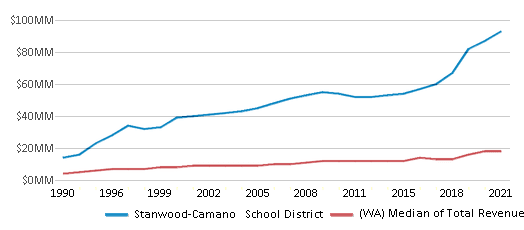
Spending
$109 MM
$21,212 MM
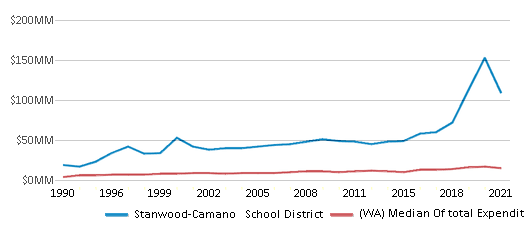
Revenue / Student
$19,141
$18,796
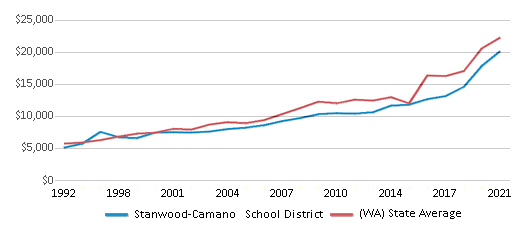
Spending / Student
$22,511
$19,246
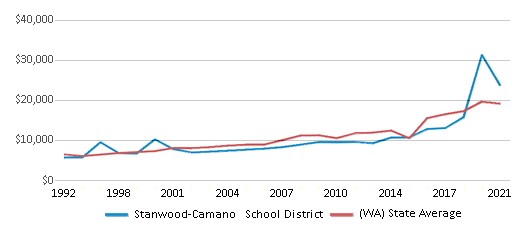
Best Stanwood-Camano School District Public Preschools (2025)
School
(Math and Reading Proficiency)
(Math and Reading Proficiency)
Location
Grades
Students
Rank: #11.
Stanwood Elementary School
(Math: 40-44% | Reading: 50-54%)
Rank:
Rank:
6/
Top 50%10
10227 273rd Pl Nw
Stanwood, WA 98292
(360) 629-1250
Stanwood, WA 98292
(360) 629-1250
Grades: PK-5
| 467 students
Recent Articles

Year-Round Or Traditional Schedule?
Which is more appropriate for your child? A year-round attendance schedule or traditional schedule? We look at the pros and cons.

Why You Should Encourage Your Child to Join a Sports Team
Participating in team sports has a great many benefits for children, there is no doubt. In this article you will learn what those benefits are.

White Students are Now the Minority in U.S. Public Schools
Increasing birth rates among immigrant families from Asia and Central and South America, combined with lower birth rates among white families, means that for the first time in history, public school students in the United States are majority-minority. This shift in demographics poses difficulties for schools as they work to accommodate children of varying language abilities and socio-economic backgrounds.





